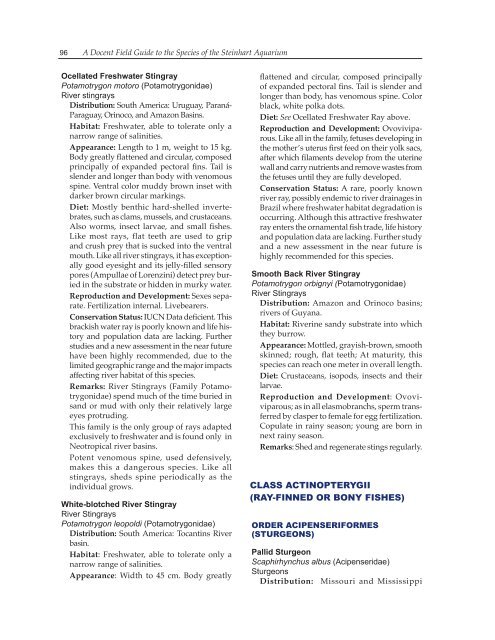THE STEINHART AQUARIUM - Gulf of Guinea Science ...
THE STEINHART AQUARIUM - Gulf of Guinea Science ...
THE STEINHART AQUARIUM - Gulf of Guinea Science ...
Create successful ePaper yourself
Turn your PDF publications into a flip-book with our unique Google optimized e-Paper software.
96 A Docent Field Guide to the Species <strong>of</strong> the Steinhart Aquarium<br />
Ocellated Freshwater Stingray<br />
Potamotrygon motoro (Potamotrygonidae)<br />
River stingrays<br />
Distribution: South America: Uruguay, Paraná-<br />
Paraguay, Orinoco, and Amazon Basins.<br />
Habitat: Freshwater, able to tolerate only a<br />
narrow range <strong>of</strong> salinities.<br />
Appearance: Length to 1 m, weight to 15 kg.<br />
Body greatly flattened and circular, composed<br />
principally <strong>of</strong> expanded pectoral fins. Tail is<br />
slender and longer than body with venomous<br />
spine. Ventral color muddy brown inset with<br />
darker brown circular markings.<br />
Diet: Mostly benthic hard-shelled invertebrates,<br />
such as clams, mussels, and crustaceans.<br />
Also worms, insect larvae, and small fishes.<br />
Like most rays, flat teeth are used to grip<br />
and crush prey that is sucked into the ventral<br />
mouth. Like all river stingrays, it has exceptionally<br />
good eyesight and its jelly-filled sensory<br />
pores (Ampullae <strong>of</strong> Lorenzini) detect prey buried<br />
in the substrate or hidden in murky water.<br />
Reproduction and Development: Sexes separate.<br />
Fertilization internal. Livebearers.<br />
Conservation Status: IUCN Data deficient. This<br />
brackish water ray is poorly known and life history<br />
and population data are lacking. Further<br />
studies and a new assessment in the near future<br />
have been highly recommended, due to the<br />
limited geographic range and the major impacts<br />
affecting river habitat <strong>of</strong> this species.<br />
Remarks: River Stingrays (Family Potamotrygonidae)<br />
spend much <strong>of</strong> the time buried in<br />
sand or mud with only their relatively large<br />
eyes protruding.<br />
This family is the only group <strong>of</strong> rays adapted<br />
exclusively to freshwater and is found only in<br />
Neotropical river basins.<br />
Potent venomous spine, used defensively,<br />
makes this a dangerous species. Like all<br />
stingrays, sheds spine periodically as the<br />
individual grows.<br />
White-blotched River Stingray<br />
River Stingrays<br />
Potamotrygon leopoldi (Potamotrygonidae)<br />
Distribution: South America: Tocantins River<br />
basin.<br />
Habitat: Freshwater, able to tolerate only a<br />
narrow range <strong>of</strong> salinities.<br />
Appearance: Width to 45 cm. Body greatly<br />
flattened and circular, composed principally<br />
<strong>of</strong> expanded pectoral fins. Tail is slender and<br />
longer than body, has venomous spine. Color<br />
black, white polka dots.<br />
Diet: See Ocellated Freshwater Ray above.<br />
Reproduction and Development: Ovoviviparous.<br />
Like all in the family, fetuses developing in<br />
the mother’s uterus first feed on their yolk sacs,<br />
after which filaments develop from the uterine<br />
wall and carry nutrients and remove wastes from<br />
the fetuses until they are fully developed.<br />
Conservation Status: A rare, poorly known<br />
river ray, possibly endemic to river drainages in<br />
Brazil where freshwater habitat degradation is<br />
occurring. Although this attractive freshwater<br />
ray enters the ornamental fish trade, life history<br />
and population data are lacking. Further study<br />
and a new assessment in the near future is<br />
highly recommended for this species.<br />
Smooth Back River Stingray<br />
Potamotrygon orbignyi (Potamotrygonidae)<br />
River Stingrays<br />
Distribution: Amazon and Orinoco basins;<br />
rivers <strong>of</strong> Guyana.<br />
Habitat: Riverine sandy substrate into which<br />
they burrow.<br />
Appearance: Mottled, grayish-brown, smooth<br />
skinned; rough, flat teeth; At maturity, this<br />
species can reach one meter in overall length.<br />
Diet: Crustaceans, isopods, insects and their<br />
larvae.<br />
Reproduction and Development: Ovoviviparous;<br />
as in all elasmobranchs, sperm transferred<br />
by clasper to female for egg fertilization.<br />
Copulate in rainy season; young are born in<br />
next rainy season.<br />
Remarks: Shed and regenerate stings regularly.<br />
CLASS ACTINOPTERYGII<br />
(RAY-FINNED OR BONY FISHES)<br />
ORDER ACIPENSERIFORMES<br />
(STURGEONS)<br />
Pallid Sturgeon<br />
Scaphirhynchus albus (Acipenseridae)<br />
Sturgeons<br />
Distribution: Missouri and Mississippi


